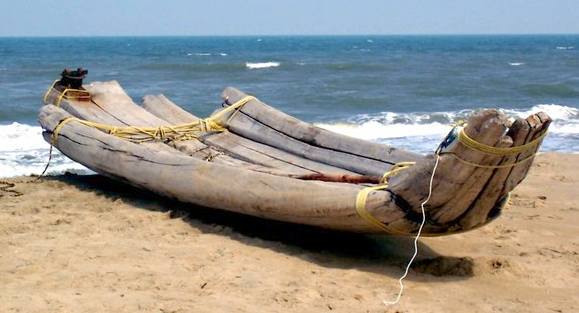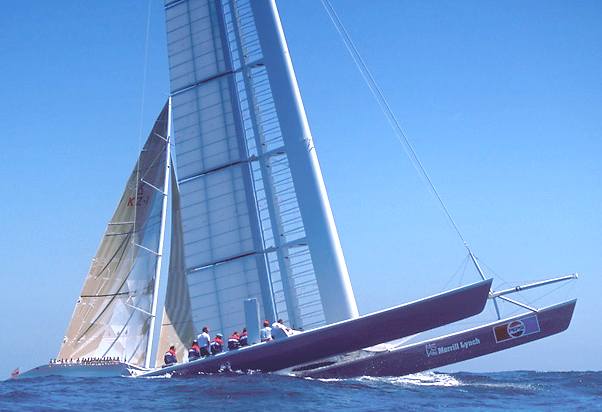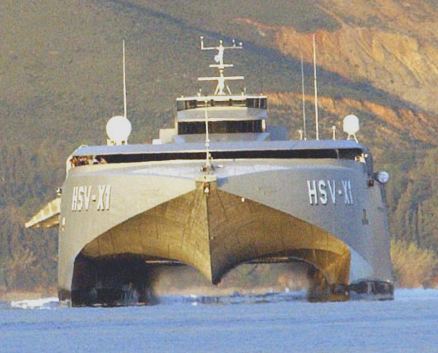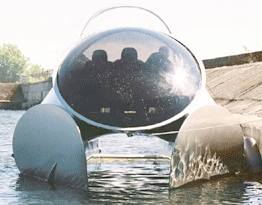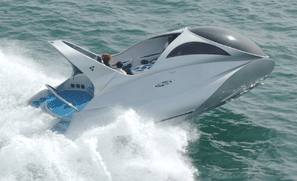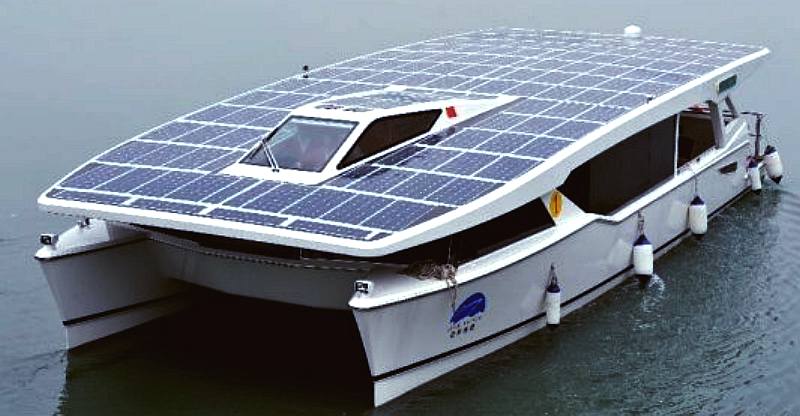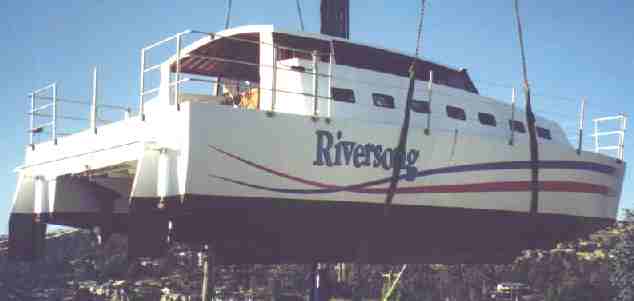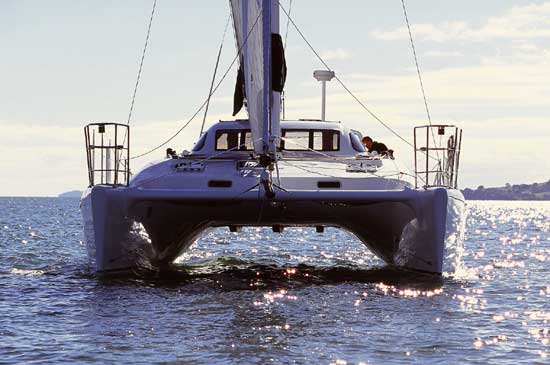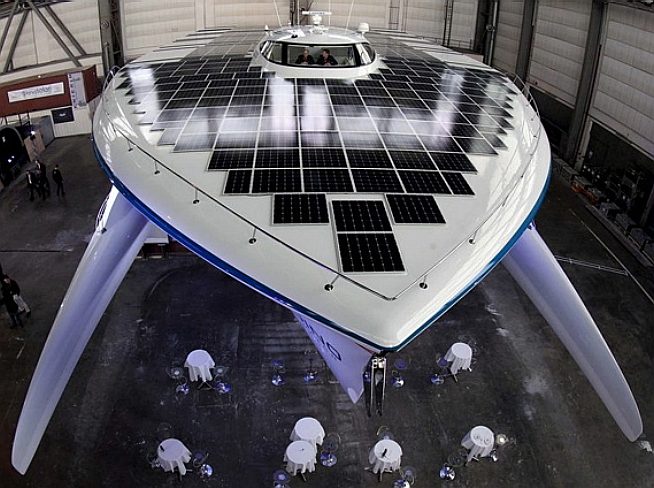|
CATAMARANS
|
||||||||||||||||||||||||||||||||||
|
HOME | BIOLOGY | BOOKS | FILMS | GEOGRAPHY | HISTORY | INDEX | INVESTORS | MUSIC | NEWS | SOLAR BOATS | SPORT |
||||||||||||||||||||||||||||||||||
|
A catamaran is a type of boat (or occasionally ship) consisting of two hulls joined by a frame. Catamarans can be sail or motor powered. The word catamaran comes from the Tamil language, in which the word kattumaram means "logs bound together". The catamaran was the invention of the paravas, an aristocratic fishing community in the southern coast of Tamilnadu, India. Catamarans were used by the ancient Tamil Chola dynasty as early as 5th century AD for moving their fleets to conquer such south-east Asian regions as Burma, Indonesia and Malaysia.
Catamarans are a relatively recent design of boat for both leisure and sport sailing, although they have been used for millennia in Oceania, where Polynesian catamarans allowed seafaring Polynesians to settle the world's most far-flung islands. Catamarans have been met by a degree of scepticism from some sailors accustomed to more "traditional" designs.
Catamaran sailing
Although the principles of sailing are the same for both catamarans and monohulls, there are some 'peculiarities' to sailing catamarans. For example:
Teaching for new sailors is usually carried out in monohulls as they are thought easier to learn to sail, a mixture of all the differences mentioned probably contributes to this. Catamarans, and multihulls in general, are normally faster than single-hull boats for four reasons:
Stars & Stripes, a racing catamaran
Catamarans are especially favourable in coastal waters, where the open spaces permit the boat to reach and maintain its maximum speed. Catamarans make good cruising and long distance boats: The Race (around the world, in 2001) was won by the giant catamaran Club Med skippered by Grant Dalton. It went round the earth in 62 days at an average speed of eighteen knots.
Catamaran designs
Popular small racing catamarans include:
Catamarans for ferries
Large experimental high-speed military catamaran
Powered Catamarans
A recent development in catamaran design has been the introduction of the power catamaran. The 'power' version incorporates the best features of a motor yacht and combines it with the traditional sailing characteristics of a multihull. Usually, the power catamaran is devoid of any sailing apparatus as demonstrated by one of the top-selling models in the United States, the Lagoon Power 43. This vessel has now been introduced to a number of charter fleets in the Caribbean and the Mediterranean and is becoming an increasingly common sight.
Mega Catamarans
One of the biggest developments over the last decade in the yachting arena has been the rise of the super catamaran - a multihull over 60 feet in length which come in semi-custom and custom designs.
Various international manufacturers are leading the way in this area including Yapluka, Sunreef, Lagoon and Privilege. A catamaran over 145 feet in length is reportedly under construction on the Eastern Seaboard of the United States.
The emergence of the super or mega catamaran is a relatively new event which is akin to the rise of the mega or super yacht which was used to describe the huge growth in luxury, large motor yachts in the French Riveria and Floridian Cost.
It takes up to one year to complete construction of one of these super catamarans and represent state-of-the-art design breakthroughs in the catamaran sector.
Paritet - manufacturer of high speed catamarans
Equipment : RECARO seats, 2 refrigerators, Hi-Fi music system 800 watt, GPS, autopilot, radar, foldable stainless steel aft railing, sonar, remote battery switch, trim tabs, electronic compass, hydraulic suspend of 3 forward seats, ventilated skipper seat, 2 auto-pumps, automatic anchor device, sun&rain canopy with side windows, hydraulic tilt of arch for easy installation of sun canopy.
New cruise version: two separate double berth cabins with air conditioning and WC/Shower room (see options)
CATAMARAN LINKS:
Moreton Bay Jig - A Jarcat 7 Cat
Ross has owned dinghies and yachts since 1968, winning many trophies in Trailer sailer events. His first trailer-sailer was a fibreglass Redwitch monohull. He then built a fibreglass cruising monohull. Promised a level ride and easy trailering, Ross built a trimaran which he used extensively both racing and cruising. When the kettle jumped out of the stove rails and his replacement vehicle was found lacking in towing ability, Ross decided to design a boat which would fulfill his requirements for a trailer sailer.
The boat needed to sail level, tow very easily and have plenty of room for his family to live aboard during holidays. Get rid of a deep keel (Moreton Bay is very shallow) and your left with a tri or cat. The cat does not have surplus weight in floats to keep balance and has double the room.
As of mid-July 2005, we moved to a new location in north Sarasota at 7010 28th St. Ct. E. Sarasota FL 34243. Since then we have also done the punchout (tramp rails, bushings, composite forestay attachment, etc, etc) on a carbon F-9 which is nearly ready to launch, and built a set of new daggerboards for a Kurt Hughes 63. We are currently building out the mechanicals and interior of a 50' Fastwater Aluminum Catamaran designed by Cortland Steck.
Email to Ross Turner. Or Phone (07) 3209 9388 Mail Address : 14 Omaru St. Loganholme, QLD 4129, Australia
YACHT LINKS:
INFORMATION FOR YACHT DESIGNERS
A modern Moby Dick adventure on the high seas by Jameson Hunter
|
||||||||||||||||||||||||||||||||||
|
This website is Copyright © 1999 & 2024 Max Energy Limited, an environmental educational charity working hard for world peace. The name Solar Navigator™, is a trademark. All other trademarks are hereby acknowledged.
|
